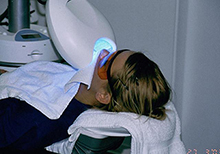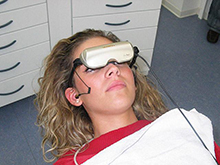It's not only the shape and immaculate condition of the teeth that play such a big part in a person's appearance, but also how bright they are. Deposits can be left on the tooth surface by dyes in food and drink, smoking and medication containing iron, and may even be a side-effect of using disinfectant mouthwashes. These dyes can penetrate pores and minscule cracks in the teeth, leading to surface discolouration which cannot be prevented by normal cleaning. The natural ageing process of the teeth - particularly when accelerated by tooth grinding - causes the nerve space in the visible part of the tooth to become smaller, reducing the amount of light they let through and robbing them of their vital brilliance.
Measures
Deposits on the surface of the teeth can be removed by a professional cleaning and polishing treatment performed by the dentist. The teeth can also be whitened by bleaching the surface from the outside, a procedure that has now become very reliable and can lighten the teeth visibly for lengthy periods of time.
Internal tooth discolouration, which is usually caused by medication taken during the patient's childhood while the teeth are developing, can only be eliminated to a minor degree using this procedure. However, this is not true of one special form of internal discolouration, i.e. the darkening of the teeth caused by root canal treatments. This can be treated extremely effectively by inserting bleach inlays into the teeth.
How it works
All bleaching gels work on the basis of a chemical reaction that releases oxygen. This causes the dye molecules to oxidise, making them invisible. These bleaches are chemically based on carbamide peroxide or hydrogen peroxide, substances that were already in general use during the post-war era for dyeing the hair ("peroxide blonde").
Systems
Manufacturers offer various bleaching systems. The systems sold in pharmacies for home use may not exceed a prescribed concentration and therefore do not brighten the teeth as effectively as those used in dental clinics.
The latest bleaching method uses both bleaching gels and activating plasma lamps. This procedure lasts 1.5 to 2 hours and lightens the teeth by about 8 shades on a predefined colour scale.
In our practice, we use only the Zoom® procedure, which is indisputably one of the most effective bleaching methods while also offering maximum tooth protection.
Professionalism
It is extremely important that this procedure is performed by experienced dental professionals, as gum tissue and exposed tooth roots must be carefully covered with a special silicon protector before the gel is applied and the area irradiated. If this doesn't happen, the patient will suffer with extremely sensitive gums and/or highly temperature-sensitive teeth for several days.
Requirements
Any type of bleaching must be preceded by a professional dental cleaning treatment performed several days beforehand, so that the bleaching gel can be applied evenly to the teeth without being repelled by plaque. Loose fillings should be at least temporarily repaired in advance in order to prevent the gel penetrating the tooth and making it too sensitive.
Only natural tooth substance can be bleached. The colour of existing fillings and crowns may no longer match the rest of the teeth once the bleaching process is complete. As we are familiar with the problems of cosmetic reconstruction, we discuss this problem in detail with the patient beforehand.
Costs
Our Zoom® bleaching procedure with gel and plasma lamp costs 350 Euro including VAT. This system is currently the best way to get pearly white teeth.
If you undergo bleaching treatment in our practice, you can also watch a cinema film via video glasses and headphones during the procedure. This will make the time pass quickly, and the dental chair may be even more comfortable than a cinema seat!
White must stay white
In order to keep your teeth beautifully white, we offer special care products such as bleach pens, mouthwash and special toothpaste.





